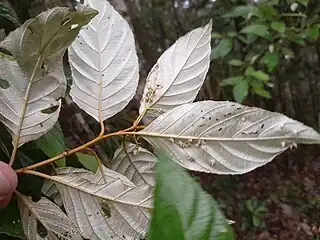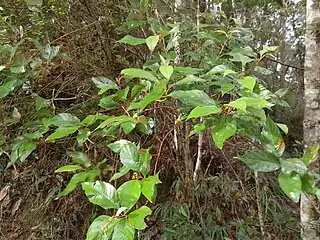| Argophyllum curtum | |
|---|---|
 | |
| Foliage | |
| Scientific classification | |
| Kingdom: | Plantae |
| Clade: | Tracheophytes |
| Clade: | Angiosperms |
| Clade: | Eudicots |
| Clade: | Asterids |
| Order: | Asterales |
| Family: | Argophyllaceae |
| Genus: | Argophyllum |
| Species: | A. curtum |
| Binomial name | |
| Argophyllum curtum | |
 | |
Argophyllum curtum is a plant in the Argophyllaceae family endemic to a small part of north eastern Queensland. It was described and named in 2018.
Description
Argophyllum curtum is an evergreen shrub growing up to 5 m (16 ft) tall.[4][5] The new growth is rusty-brown in colour due to a dense covering of brown hairs. The leaves are dark green and hairless above and silvery below, and they measure up to 17 cm (6.7 in) long by 7 cm (2.8 in) wide.[4][5] They are arranged alternately on petioles measuring from 1.3 to 2.8 cm (0.51 to 1.10 in) long.[4][5] They each have 6 to 9 lateral veins on either side of the midrib. The leaf margins (edges) are finely toothed with between 23 and 38 teeth on either edge, the largest of which are just 1 mm (0.039 in) long.[4][5]
The inflorescences are produced from the leaf axils, may be up to 9 cm (3.5 in) long and are densely covered in hairs.[4][5] Flowers are white with 5 petals, measuring about 1 cm (0.39 in) across.[4][5]
The fruit is a capsule up to 3.5 mm (0.14 in) long and 5.5 mm (0.22 in) diameter.[4][5]
Phenology
Flowering has been observed from May to October, and fruit appear from June to November.[5][6]
Taxonomy
In 2018 the Australian botanists Anthony Bean and Paul Forster conducted a review of the Australian members of the genus Argophyllum, with the result that 7 new species – including A. curtum – were described. Their paper, titled "A taxonomic revision of Argophyllum J.R.Forst. & G.Forst. (Argophyllaceae) in Australia", was published in the Queensland Herbarium's journal Austrobaileya. The type specimen was collected in 2005 near Cairns by Forster.[5][2][3]
Etymology
The genus name Argophyllum is derived from Ancient Greek Árgos meaning white or shining, and phúllon meaning leaf. It refers to the white colouration of the underside of the leaves.[5] The species epithet curtum is from the Latin curtus, meaning short, and refers to the very small teeth on the margins of the leaves.[2][5]
Distribution and habitat
A. curtum is restricted to a small area of the Wet Tropics of Queensland between Kuranda and Edmonton near Cairns.[4][5] There are 5, possibly 6, populations in that area (one that was previously reported has not been relocated since).[5] It is found in open forest and on the margins of streams in complex notophyll rainforest, usually on granitic alluvial soils.[4][5] The altitudinal range is between 120 and 630 m (390 and 2,070 ft).[4][5]
Conservation
The taxon authors conceded that there are no immediate threats to this species, but also noted that the available habitat is small and potentially subject to detrimental forces.[5] They suggested that a vulnerable status be applied to the species,[5] however the Queensland Department of Environment and Science has assessed it as least concern.[1] As of 5 November 2023, it has not been assessed by the International Union for Conservation of Nature (IUCN).
Gallery
 Silvery underside of leaves
Silvery underside of leaves Habit
Habit Flower buds and rusty coloured new growth
Flower buds and rusty coloured new growth
References
- 1 2 "Species profile—Argophyllum curtum". Queensland Department of Environment and Science. Queensland Government. 2019. Retrieved 26 August 2021.
- 1 2 3 "Argophyllum curtum". Australian Plant Name Index (APNI). Centre for Plant Biodiversity Research, Australian Government. Retrieved 26 August 2021.
- 1 2 "Argophyllum curtum A.R.Bean & P.I.Forst". Plants of the World Online. Royal Botanic Gardens, Kew. 2023. Retrieved 6 November 2023.
- 1 2 3 4 5 6 7 8 9 10 F.A.Zich; B.P.M.Hyland; T.Whiffen; R.A.Kerrigan (2020). "Argophyllum curtum". Australian Tropical Rainforest Plants Edition 8 (RFK8). Centre for Australian National Biodiversity Research (CANBR), Australian Government. Retrieved 26 August 2021.
- 1 2 3 4 5 6 7 8 9 10 11 12 13 14 15 16 17 Bean, A.R.; Forster, P.I. (2018). "A taxonomic revision of Argophyllum J.R.Forst. & G.Forst. (Argophyllaceae) in Australia" (PDF). Austrobaileya. 10 (2): 207–235. Retrieved 26 August 2021.
- ↑ "Argophyllum curtum". iNaturalist. Retrieved 5 November 2023.
External links
 Data related to Argophyllum curtum at Wikispecies
Data related to Argophyllum curtum at Wikispecies Media related to Argophyllum curtum at Wikimedia Commons
Media related to Argophyllum curtum at Wikimedia Commons- View a map of historical sightings of this species at the Australasian Virtual Herbarium
- View observations of this species on iNaturalist
- View images of this species on Flickriver